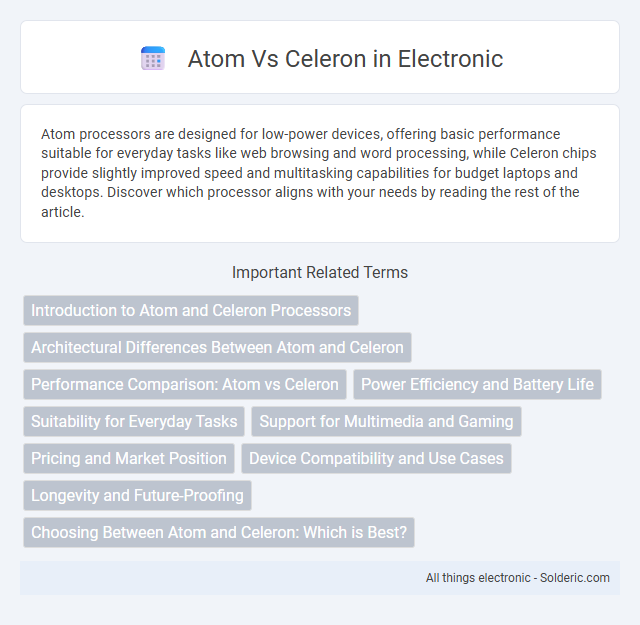Atom processors are designed for low-power devices, offering basic performance suitable for everyday tasks like web browsing and word processing, while Celeron chips provide slightly improved speed and multitasking capabilities for budget laptops and desktops. Discover which processor aligns with your needs by reading the rest of the article.
Comparison Table
| Feature | Intel Atom | Intel Celeron |
|---|---|---|
| Processor Type | Low-power, entry-level CPU | Entry-level desktop and laptop CPU |
| Performance | Designed for energy efficiency; lower performance | Better performance, suitable for basic computing tasks |
| Cores / Threads | Typically 2-4 cores, limited multithreading | Usually 2-4 cores, supports hyper-threading |
| Clock Speed | Ranges from 1.1 GHz to 2.0 GHz | Ranges from 1.8 GHz to 3.5 GHz |
| Cache Size | 512 KB to 2 MB L2 Cache | 2 MB to 4 MB L3 Cache |
| Target Devices | Tablets, netbooks, embedded systems | Budget laptops, entry-level desktops |
| Power Consumption | Very low TDP (~2W to 6W) | Higher TDP (~15W to 35W) |
| Integrated Graphics | Basic Intel HD graphics | Improved Intel UHD Graphics |
| Price Range | Lower cost, budget-friendly | Affordable, mid-range budget |
| Use Cases | Basic web browsing, light tasks, IoT | Office applications, media playback, casual gaming |
Introduction to Atom and Celeron Processors
Intel Atom processors are designed for low-power devices such as tablets, netbooks, and embedded systems, delivering efficient performance with minimal energy consumption. Celeron processors target budget-friendly entry-level desktop and laptop markets, offering higher clock speeds and better multitasking capabilities compared to Atom chips. Both processor lines emphasize affordability but differ significantly in power efficiency and performance benchmarks.
Architectural Differences Between Atom and Celeron
Intel Atom processors feature a simplified, low-power architecture designed for energy efficiency in mobile and embedded devices, utilizing in-order execution cores. In contrast, Celeron processors employ a more complex out-of-order execution architecture, derived from the higher-performance Intel Core line, targeting budget desktops and laptops. Atom chips prioritize minimal power consumption and integrated graphics for basic tasks, while Celerons balance moderate performance and cost with broader compatibility for everyday computing.
Performance Comparison: Atom vs Celeron
Intel Atom processors deliver energy-efficient performance ideal for basic tasks and light computing, while Celeron chips offer higher processing power suitable for entry-level laptops and desktops handling everyday applications. Celeron CPUs typically feature higher clock speeds, larger cache sizes, and better multitasking capabilities compared to Atom processors, resulting in smoother performance for web browsing, office work, and media consumption. When choosing between the two, your decision should be based on whether you prioritize battery life and compact design (Atom) or improved speed and responsiveness (Celeron).
Power Efficiency and Battery Life
Intel Atom processors are designed with ultra-low power consumption, making them ideal for devices requiring extended battery life such as tablets and entry-level laptops. In comparison, Intel Celeron CPUs consume more power due to higher clock speeds and performance capabilities, resulting in shorter battery duration in portable devices. Devices equipped with Atom processors typically achieve longer usage times per charge, emphasizing their superior power efficiency in energy-sensitive applications.
Suitability for Everyday Tasks
Intel Atom processors offer low power consumption and basic performance suitable for simple everyday tasks like browsing, emailing, and streaming media. Celeron CPUs provide higher clock speeds and better multitasking capabilities, making them more suitable for demanding activities such as light gaming, document editing, and running multiple apps simultaneously. For users prioritizing efficiency and battery life, Atom is ideal, while Celeron delivers enhanced responsiveness and smoother performance for broader everyday use.
Support for Multimedia and Gaming
Atom processors offer limited support for multimedia and gaming, often struggling with high-definition video playback and modern gaming titles due to lower clock speeds and fewer cores. Celeron chips, while still entry-level, typically provide better multimedia performance with enhanced graphics capabilities and support for smoother video streaming and casual gaming. Your multimedia experience and gaming performance will improve with a Celeron, especially for basic tasks and older games.
Pricing and Market Position
Intel Atom processors are positioned as low-cost, entry-level chips primarily designed for budget laptops, netbooks, and embedded devices, featuring competitive pricing that appeals to cost-sensitive consumers. In contrast, Intel Celeron processors offer a slightly higher performance tier with moderate pricing, targeting budget desktops and entry-level laptops while balancing affordability and improved capabilities. Market-wise, Atom chips dominate ultra-mobile and power-efficient segments, whereas Celeron captures value-driven users needing basic computing power for everyday tasks.
Device Compatibility and Use Cases
Atom processors excel in low-power devices like tablets, netbooks, and entry-level laptops, offering sufficient performance for web browsing, email, and light productivity tasks. Celeron chips, generally found in budget laptops and desktops, provide better multitasking capabilities and compatibility with more demanding applications such as office suites and basic multimedia editing. Your choice between Atom and Celeron will depend on whether you prioritize energy efficiency and portability or slightly higher performance for everyday computing needs.
Longevity and Future-Proofing
Intel Atom processors are designed for energy efficiency and basic tasks, offering limited longevity and future-proofing due to minimal performance headroom and outdated architecture. Celeron chips provide better processing power and support for newer technologies, enhancing your device's lifespan and ability to handle evolving software demands. Choosing a Celeron CPU ensures improved future-proofing, making it a more suitable option for long-term use.
Choosing Between Atom and Celeron: Which is Best?
Choosing between Intel Atom and Celeron processors depends on your usage needs and budget constraints. Atom chips offer energy-efficient performance ideal for basic tasks and lightweight devices, while Celeron processors deliver better multitasking and higher clock speeds suitable for more demanding applications. Your best choice balances power consumption with performance requirements for everyday computing or business use.
Atom vs Celeron Infographic

 solderic.com
solderic.com